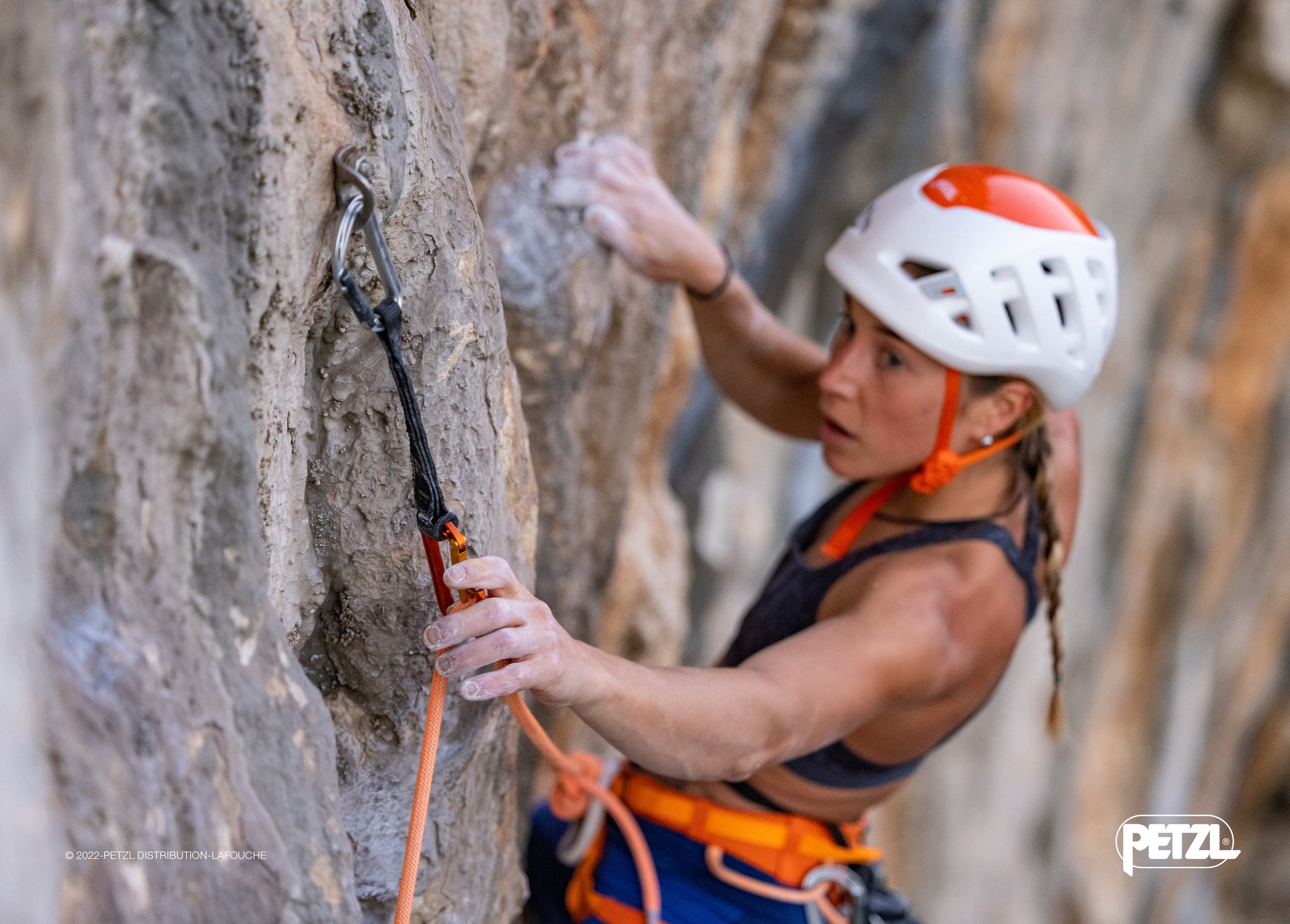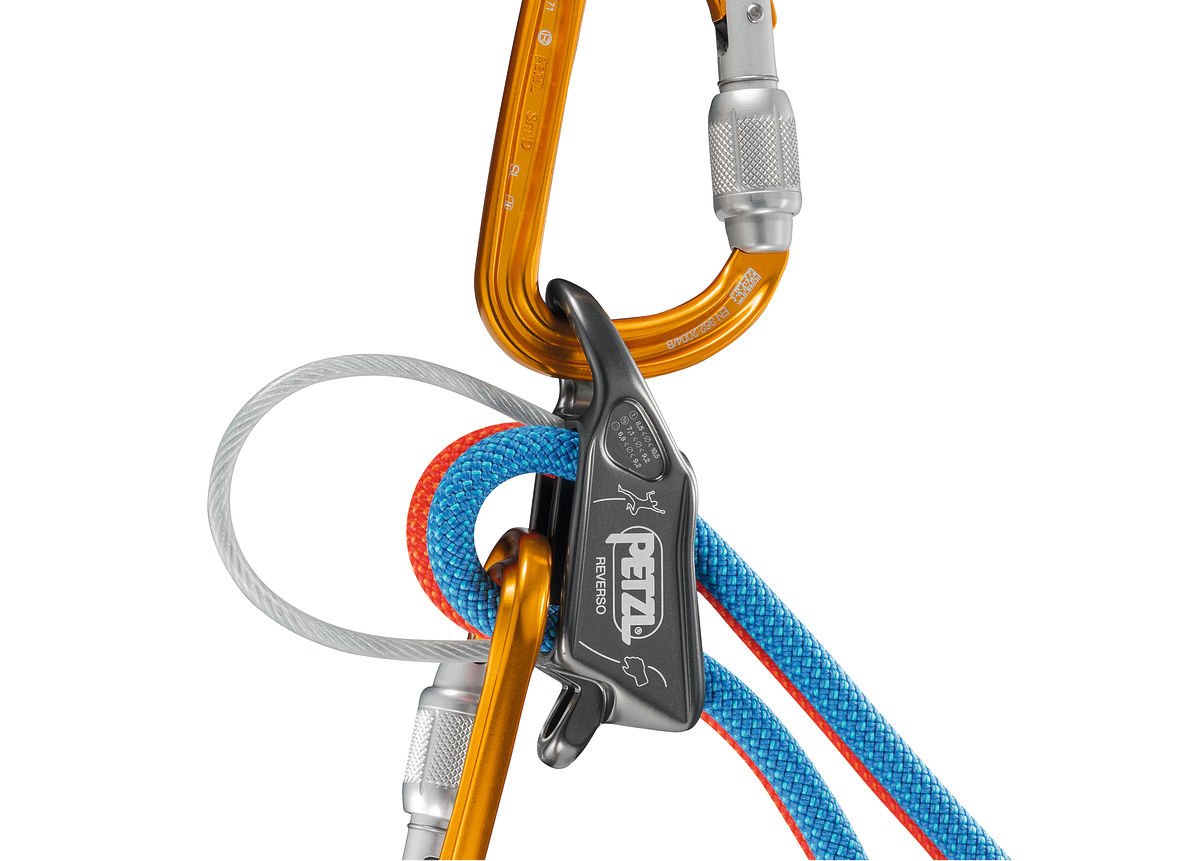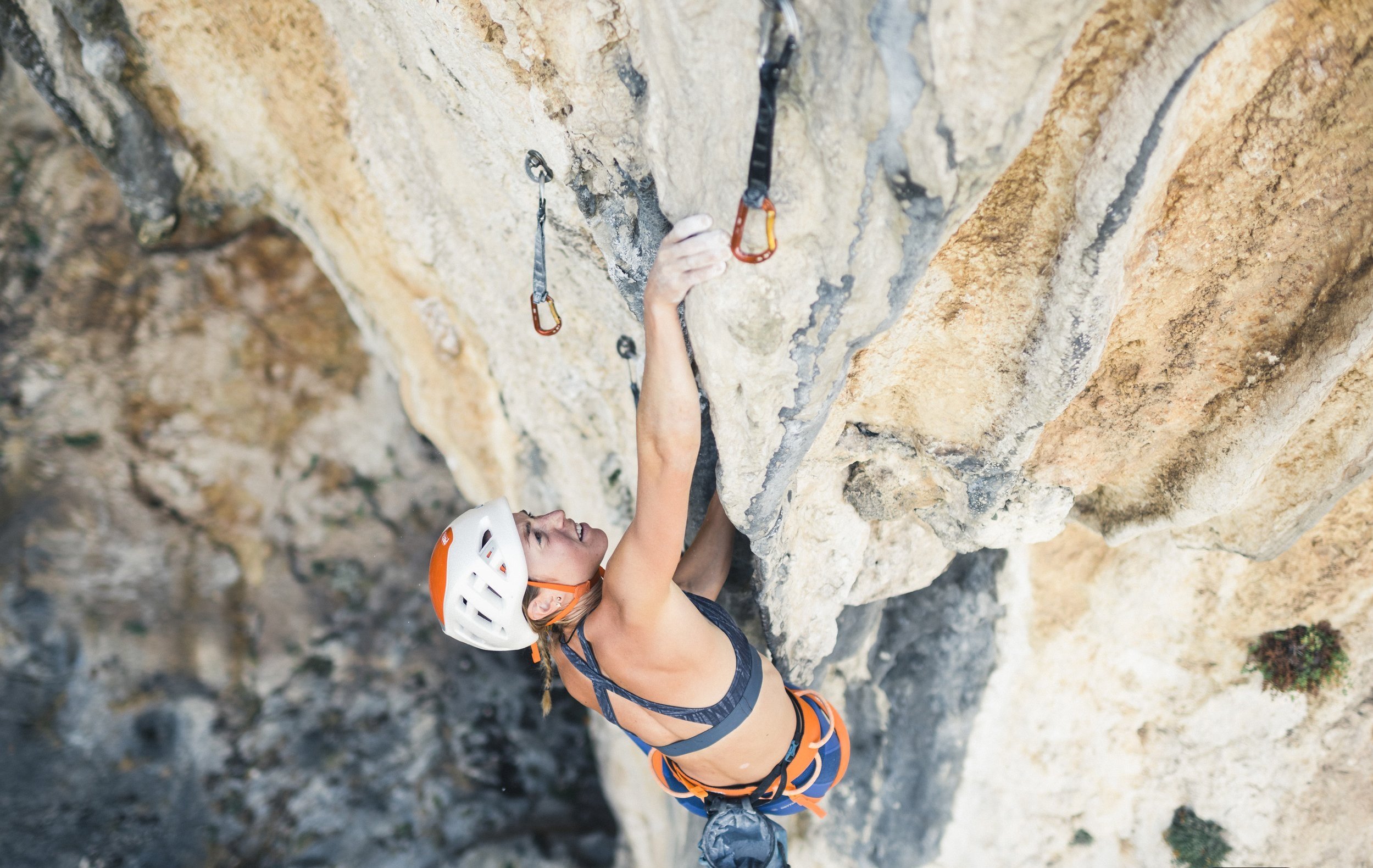
Essential Rock Climbing Gear Guide
Rock
Our guide team tests and reviews some of the best gear in the industry. This catalog shares rock climbing-specific clothing and the gear our team uses daily. They are broken into categories for easy access: Clothing, Gear Essentials, Top Roping, Sport Climbing, and Traditional Climbing.
Each link above is a toggle to move you down this page to the style of climbing you would like to review. You will stay on the same page and can scroll up or down to preview other category information at any time.
CLOTHING
WARMER WEATHER
The sun is intense and hydration is vital! Hydrate the night before your climb/ hike. Consider freezing water bottles or putting ice in them on hot days. Light-colored and loose-fitting clothing will help keep you cool.
UPPER LAYERS
Layer 1- Synthetic Sun Hoody
Mountain Equipment Women’s Glace Hoody or Men’s Glace Hoody
Sun Hoodys have revolutionized our climbing layering system. This next-to-skin layer blocks UVs without needing to add greasy sunscreen and still keeps us cool in the heat. This is a staple piece for almost all adventures in every season.
Layer 2- Fleece
Mountain Equipment Lumiko Grided Fleece Hoody
Grided fleeces are a proven technology. They breathe well and add more warmth than a sun hoody, and this piece has a good chest pocket for storing a phone and other small valuables. The Patagonia R1 is the industry standard.
This layer and the sun hoody are interchangeable based on temperature and output for the day. Having a hood is a preference and should be supplemented as needed. This layer also typically takes rock abuse better than others, making it a great climbing layer for crack and chimney climbing. Yes, we wear a tee underneath.
Layer 2 or 3- Windshell Jacket
Mountain Equipment Squall Jacket
Climbing environments change rapidly but we are climbing and still need to be light! This piece is a light, weather-protection, and wind-resistant shell that keeps body heat in when the weather starts to turn. This great on-route jacket packs small, clips easily to your harness, and works in light precipitation.
BOTTOM LAYERS
Layer 1-Synthetic Short
Mountain Equipment Comici Shorts
The Comici line is one of the best softshell lines in the industry, making it the standard. Keep in mind that longer shorts may sit better while wearing a harness.
Layer 1- Synthetic Pant
COOLER WEATHER
ADDITIONAL UPPER LAYERS
Layer 2 or 3- Mid Layer
Mountain Equipment Andola Hooded Jacket or a lighter option, Switch Pro Hooded Jacket
An additional synthetic jacket as a layering and active climbing piece, the Switch Pro breaths flawlessly and is essential as a mid-weight layering piece in colder weather. This piece insulates the core, keeping you warmer, and breathes when you need it during high-output activities.
Layer 4 or 5- Insulation Layer/ Belay Jacket
Mountain Equipment Oreus Hooded Jacket
A belay jacket for windy ridges and higher altitude climbing areas is mandatory. The Oreus Jacket is the result of a 5-year development project to make what we believe to be the best mid-weight synthetic product currently available. Limited by the synthetic fills on the market, we set out to develop our own weaving fibers through heat-reflective fabric technology. Now patent pending and unique to Mountain Equipment, Aetherm™ Precision Insulation is warmer than anything of equivalent weight as well as being more breathable and more packable.
BOTTOM LAYERS
Layer 1 or 2- Synthetic Pant
Mountain Equipment Comici Pants
Light, breathable, and full range of motion softshell pants with nice design curves and articulated knees for climbing.
Layer 1 or 2- Heavier Weighted Synthetic Pant
Mountain Equipment Women’s Chamois Pant, Men’s Ibex Pant
High alpine conditions demand the same function as lighter climbing pants with the same full range of motion, nice design curves, and articulated knees for climbing in cooler temperatures.
ACCESSORIES
Sun Hat
Smile Mountain Guides Happy Camper 5 Panel Hat
Keeping the shade off your face is yet another way to prevent burns. We also like wearing hats whenever we have hoods up, as it helps keep our vision clear since the hood's brim is not in the way.
Water Bottle
MSR Dromlite 2L or Life Straw Squeeze System
We usually prefer a collapsible bladder on a climbing tour. The more you drink, the smaller it gets. We bring the 2L on routes but do not often fill it up all the way. This is a good option for saving space in your on-route climbing pack.
Food: Energy Bars, Fruit, Sandwiches, Trail Mix. 100 Calories an hour!
Sunglasses
Smith’s Guide’s Choice Lenses
These have a great fit and feel for hiking and climbing, with a variety of lens options for high and low-light adventures.
Sunscreen/ Lip balm -
Buff
Smile Mountain Guides Neck Gaiter
A buff is handy in any weather. It covers body parts to help block the sun, and in the cold, it becomes an easy way to block the wind from your ears. We wear buffs all the time in the field!
GEAR ESSENTIALS
FOOTWEAR
Sticky Rubber Approach Shoes
Approach shoes are designed with a sticky rubber sole for added grip on approaches and descents of rock climbs. The TX-2 is a lighter, more breathable version for warmer weather and an ideal on-route shoe. As you move up in the TX family, the shoes start to provide more support and offer more durability. Choose a model that works best for the terrain you’ll be hiking and climbing in.
Climbing Shoes
Evolv Rave, Evolv Generals, La Sportiva TC Pros, Evolv Zenist, Evolv Shamans
Picking the right climbing shoes is very personal! First, the best shoe is the one that fits your foot the best. We encourage you to find a shoe that fits well and is not uncomfortably tight…
We wear Evolv Raves, or slipper-type shoes, most when guiding. They are excellent desert crack shoes and everyday performers that can edge and smear venues like Eldorado Canyon. They are also especially adept for alpine rock climbs because we can slide them on and off quickly, wear a sock with them, and pack them quickly in a bag.
Evolv Generals and La Sportiva TC Pros are great all-around climbing shoes with a stiffer midsole and rand. They provide better foot support and edge than slippers, which is a consideration if you climb longer, all-day routes. The high-top version also protects your feet and ankles. We prefer these on granite.
Evolv Zenist and Evolv Shamans trend toward steeper climbing. Both shoes have a down-cambered midsole and down-turned toebox that acts like a hook for your toes. This helps you pull in with the lower half of your body on the wall and will help keep the tension on steeper routes. Performance climbing that requires techniques such as heel-hooking and toe-hooking are also reasons we would pick up these shoes. We interchange them based on the climb.
PERSONAL CLIMBING ITEMS
Helmet
Both helmets are light and have full top and side impact ratings. They are also ski-rated, making these ideals if you’re multi-disciplined.
Harness
Having tested many harnesses, the Hirundos is a great blend of durability, packability, and versatility. We use this harness year-round, from sport climbing and long trad routes to ice climbing in the winter. If you are looking for a slightly lighter, lower-profile version that sacrifices some durability, the Sitta is for you!
Ropework / Belay Gloves
Gloves increase security and comfort when managing a rope. We always belay with gloves, both outside and in the gym, and use them for rappelling on longer multi-pitch objectives.
Chalk Bag
Evolv Andes Chalk Bag
You have to find the perfect one for you!
Preview our comprehensive medical kit supported by the medical director of many guide services, Alan Oram.
Communication Devices
Cell Service - Smart Phone
Having climbing apps on your phone will really make this a more versatile tool. Gaia, Mountain Project, and Topo Maps are all great. Download zones before leaving service.
Remote Garmin InReach Mini
This is a reliable backcountry emergency communication device that can be programmed to your phone for easier use in the field. It’s a must-have.
Remote (Multiple Climbing Parties ) - Wouxun Dual Band VHF/UHF 200 Handheld Commercial Radio
These are specific tools for backcountry climbing with multiple parties in an area. You can program channels and communicate easily between groups.
Climbing Backpacks
On Route Climbing Pack - Creek 20 or Speed 22
These have proven to be great all-around climbing backpacks with nice, simple features. Look for a sleek design that prevents snagging as you climb. Then, decide on the type of durability you want in the pack. For the Speed 22, we completely strip this pack down and remove the brain for multi-pitch rock climbing. Typically, the Speed Series stuffs well inside of a larger backpack. For days in Eldo or Red Rock, where we hike in and climb with the same bag, we defer to the Creek 20. It’s easy to hike with, packs all of our climbing gear, has a short torso for better climbing movement, and is extremely durable. We prefer cinch-closure tops for our on-route pack to help with overstuffing, which happens a lot when you have a smaller pack!
Crag Pack - Black Diamond Creek 35 or Creek 50
A pack’s weight, size, and features vary wildly. We look for a simple and durable design that carries well. We are less concerned with the weight. Generally, we are not taking this pack to remote areas with long approaches.
Guidebook - Mountain Project
TOP ROPING
SPECIFIC GEAR ITEMS
Belay Device and Attachment Carabiner
Petzl GriGri and Petzl Sm’D TRIACT-LOCK
The GriGri and Sm’D are a good combination of tools. They work well together. The GriGri is nice for top-roping and is a useful tool for rescues in a single-pitch environment.
6 Additional Locking Carabiners
You’ll have the versatility to build top rope anchors and spare lockers for any issues that come up within the climbing day. These also transfer to good multi-pitch carabiners.
Rope
Having a slightly thicker / heavier rope will help with wear. The 9.5 mm diameter is still lightweight enough for climbing but offers more longevity.
Anchoring Static Rope
Sterling 3/8” HTP Static Rope 30 m
If you need to build anchors that are recessed from the cliff, you will need a static rope. The HTP line has minimal stretch, knots well, and will not absorb water so you can use it year-round.
Directionals
Petzl ANGE Finesse Quickdraw and Black Diamond C4’s
Directionals are a nice option to have for redirecting the rope over different climbs without having to move the anchor. Efficiency = more climbing.
Rope Tarp
Useful for keeping ropes clean! We stuff this in our backpacks.
SPORT CLIMBING
SPECIFIC GEAR ITEMS
Dynamic Climbing Rope
Lighter ropes minimize the effects of weight while you’re climbing. We find that a 9.0mm to 9.2mm rope works well for sport climbing while still feeling light enough to not intrude on the climbing. We opt for a slightly more durable rope at the 9.2mm diameter.
12 -14 Quickdraws
Petzl Spirit Express Quickdraw
The number is specific to the area you will be climbing in; however, 12-14 quickdraws will get you up routes in most climbing areas in the lower 48.
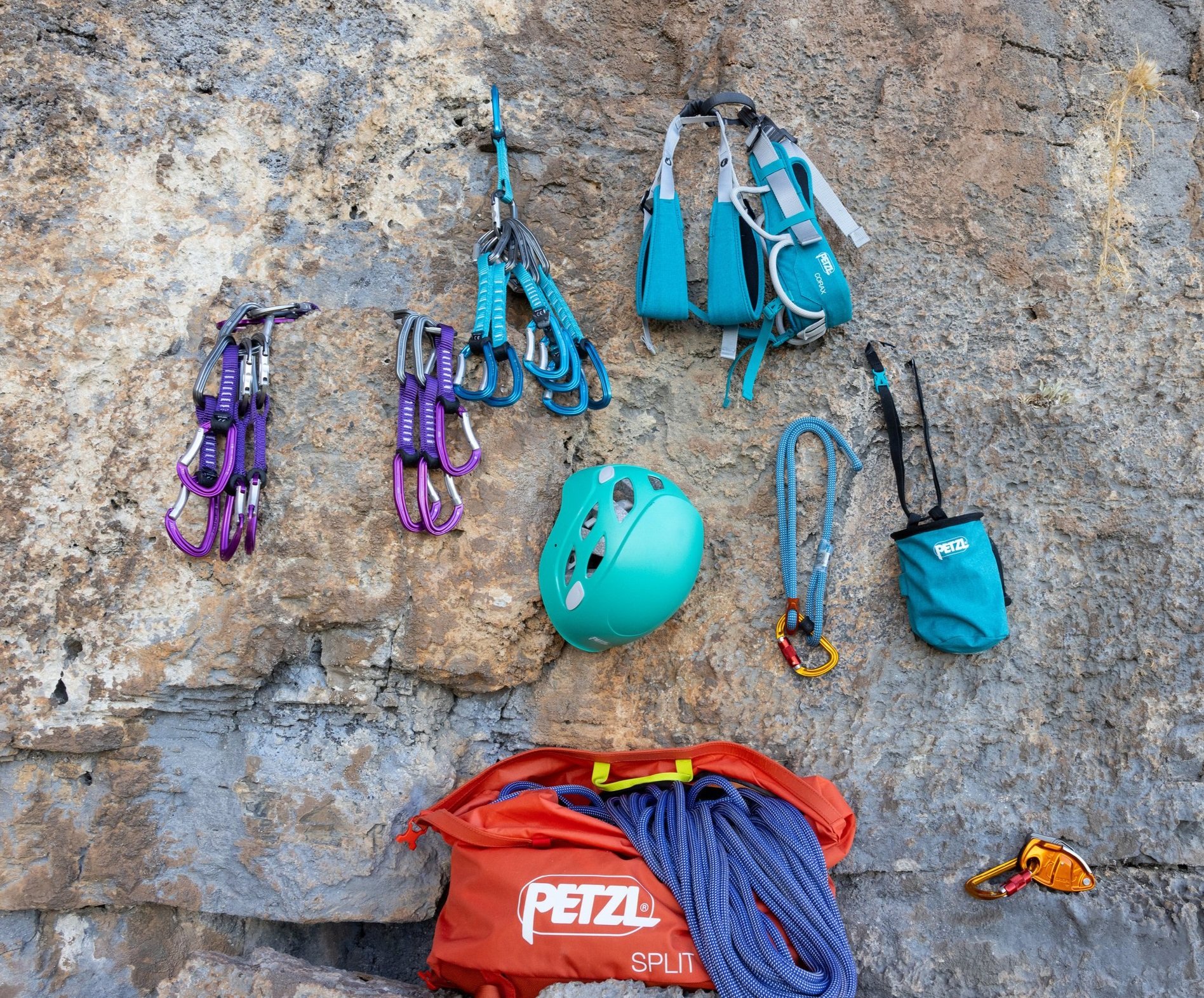
Lockerdraw
x2 Petzl Sm’D locking carabiners on a Petzl Finesse Dogbone
If you are top-roping routes after leading the climb, have the leader place one regular quickdraw and a locked draw, opposite and opposed, on the bolts for an anchor. This creates a strong, confidence-inspiring top-roping anchor for those who want to follow, lead, and clean.
2 Additional Locking Carabiners
It’s nice to have some extra gear for cleaning routes.
Belay Device and Attachment Carabiner
Petzl GriGri and Petzl Sm’D TRIACT LOCK
Using an assisted braking device, such as the GriGri, for sport climbing has become standard practice. These devices reduce the force a belayer feels at the device itself and on the brake hand, creating higher security margins. The added braking mechanism also helps when a partner needs to take extended rests on the rope while suspended off the ground ( projecting ).
Personal Anchoring System ( PAS )
This is a good tool to have in the backpack for cleaning routes. Please do not clip it to the harness and climb with it all day, only for cleaning the route!
Anchoring Cord or Sling
While sport climbing, it is sometimes useful for the leader to build a more traditional anchor for a longer projecting session on a top rope. Having materials available to build an anchor like this is key.
Stick Clip
The SuperClip on Painter Pole
Some sport climbing areas have been designed with stick clips in mind. Not having one may mean climbing 20 feet to the first bolt and risking a nasty groundfall. Researching the areas you are going to climb in is key.
Rope Tarp
Useful for keeping ropes clean! We stuff this in our backpacks.
TRADITIONAL CLIMBING
SPECIFIC GEAR ITEMS
Dynamic Climbing Rope(s)
1:1 w/ walk-off or 30 m rappels - Petzl Volta Guide 9.0 mm, 60 m
1:1 w/ hard climbing a full length rappels - Petzl Volta Guide 9.0 mm, 60 m & Petzl Paso Guide 7.7 mm, 60 m as a tagline
or
x2 Petzl Paso Guides 7.7 mm, 60 m, different colored ropes
2:1 - x2 Petzl Volta 9.2 mm, 60 m, different colored ropes
Double Rack of Larger Camalots
Black Diamond C4’s, .3-3, and 1, C4 #4
If you are a competent climber at the grade, having a double rack of cams along with what is listed below will get you up (and down) almost any free climb that takes a variety of gear. This is not an exhaustive aid-gear list or a specialized rack for places like Moab or Indian Creek.
Single Rack of Smaller Camalots
Sometimes, you need smaller gear!
Single Stopper Set
Offset Stopper Set #7-#11 with some additional smaller pieces
Stoppers are excellent anchor pieces to incorporate into the overall climbing system to help save cams for the next pitch, and sometimes they are also the best tool for cracks that constrict. We find offset stoppers only add value with their shape. They fit where any traditional stopper can, benefiting from wedges that wedge into more flaring cracks.
Nut Tool
This is a light and durable nut tool that clips easily to your harness. Can’t ask for much more.
2-4 Shoulder Length Slings
Petzl Pur’Anneau 60 cm, x1 Petzl ANGE S Carabiner
Having a variety of gear options and knowing which tool to use when is what trad climbing is all about! Having a selection of draws and slings will aid in versatility.
6 Quickdraws
Petzl ANGE Finesse Quickdraw or 6 Alpine Draws- Petzl Pur’Anneau 60 cm, x2 Petzl ANGE S Carabiner
Read above. Quickdraws are a fast tool for clipping traditional pieces when an extension is not needed. They also clip fixed gear and pieces quickly and with some additional security. Alpine draws in a quickdraw configuration offer the versatility of an extension from an alpine draw with the minimal length of a traditional quickdraw.
120 cm Sewn Sling
Edelrid Aramid Cord Sling 6 mm
This is a fantastic material for building a rappel extension. It’s strong and abrasion-resistant, and knots are easy to untie after weighting.
Plaquette Styled Belay Device
Petzl Reverso and/or Kong GiGi
You need a device that can belay in “guide mode”, this is a great, lightweight, option.
5 Locking Carabiners
5 total allows for options on the ascent, descent, and if performing a rescue.
Rappel Tether
This is a good tool to have in the backpack for descending multi-pitch routes. The dynamic properties of the rope and its ability to adjust to many anchor stances make it a must. We prefer the Petzl Dual Connect Vario.
Anchoring Sewn Sling
Sewn slings as anchors have become very popular because of their reduced bulk and ease of use. We like 1 on the harness.
Anchoring Cordelette
Sterling 5.9 mm Powercord 18’ or Sterling 5.4 mm V-TX Cord
Having a slightly longer cord helps when connecting disparate anchor points and for slinging natural features that become incorporated into an anchor. This versatility and the abrasion resistance of the Powercord add to its value.
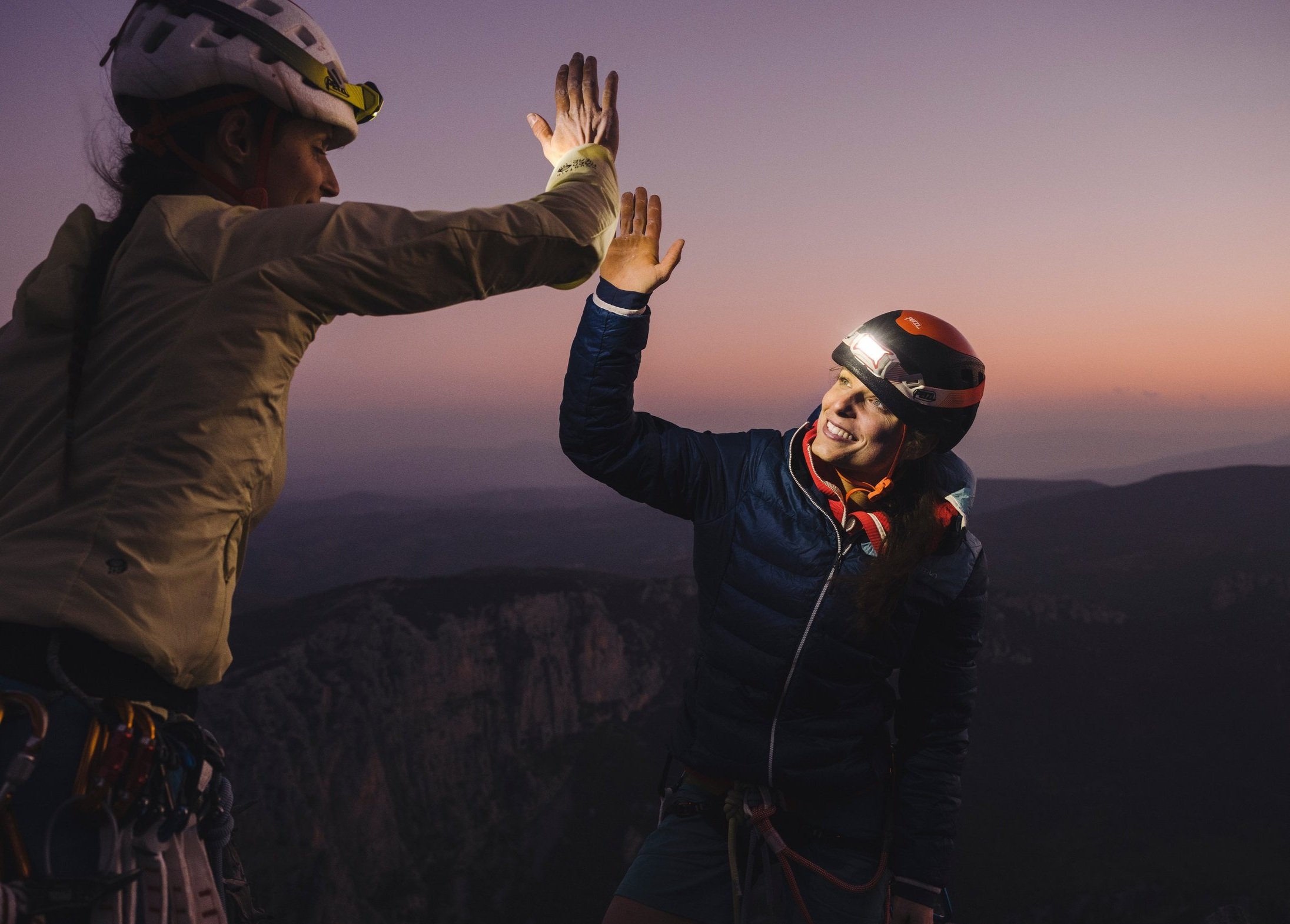
Autoblock Cord
Sterling's 6mm Sewn Auto Block
Useful friction hitch material for rappels and rescues.
Rappel Ring or Quicklink
If you need to bail, having a ring or link to rappel off is nice. Depending on which you choose, they are strong and durable, and it is next to impossible for the rope to pop out after being threaded. You can also use the myriad carabiners on your rack for the light and fast option, but non-locking carabiners should not be used to replace anchor/rappel stations.
Knife
A helpful part of the bail kit for cleaning tatted anchors and rappel stations and cutting new material to build better anchors at the stations mentioned above. This item and other bail kit items stay in our backpacks while climbing.
Headlamp
Petzl Swift RL and/or Petzl Bindi
Essential for early morning navigation to the base of longer climbs and a backup/ security piece when night falls and you are still en route or descending back to the trailhead. Bring this on long routes; you can’t predict when time plans will change! The RL is slightly more powerful, and we will use it for multi-day rock trips when we need a rechargeable headlamp. The Bindi is excellent for early morning day missions where we need light.







